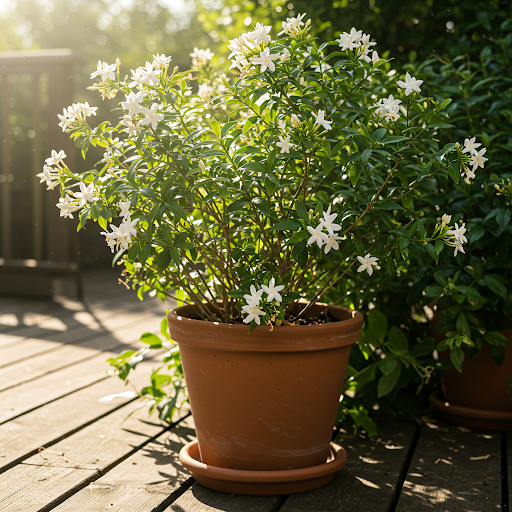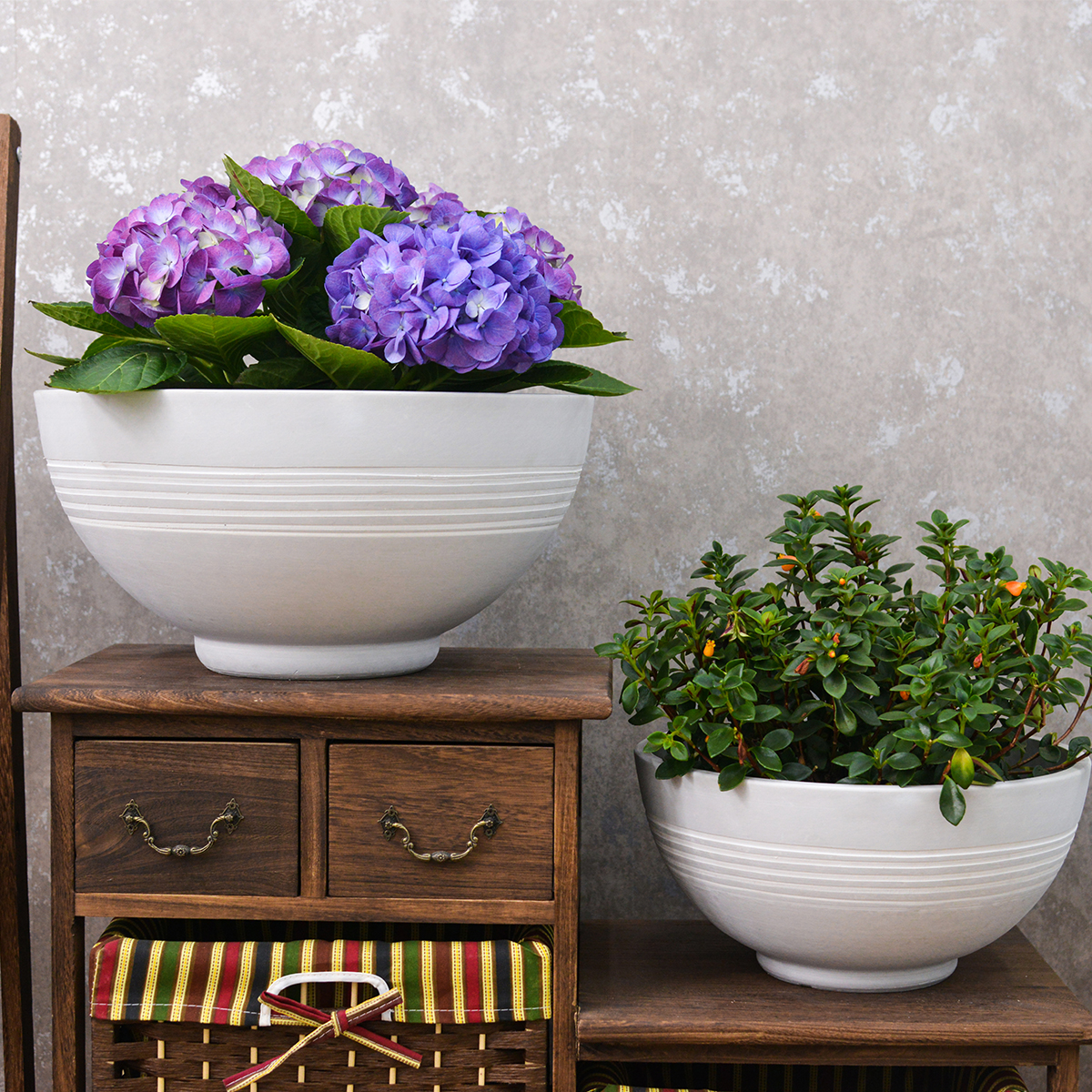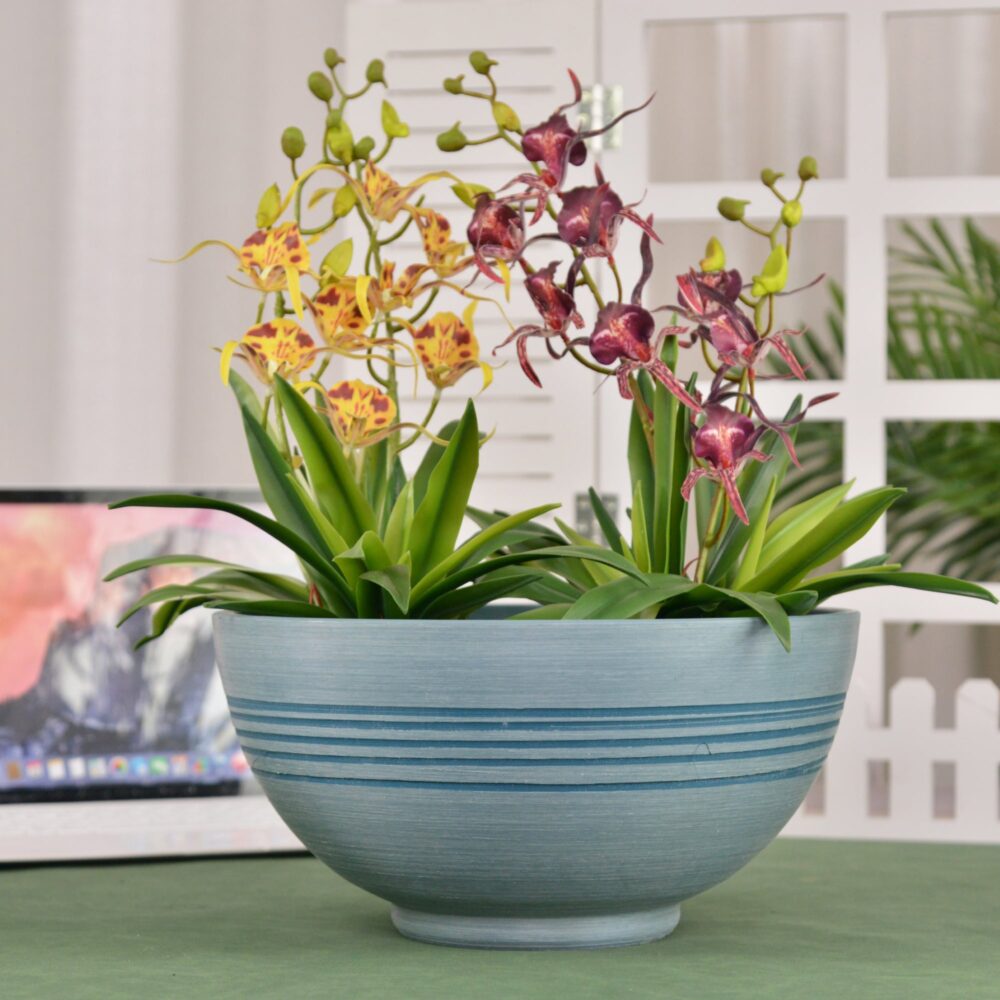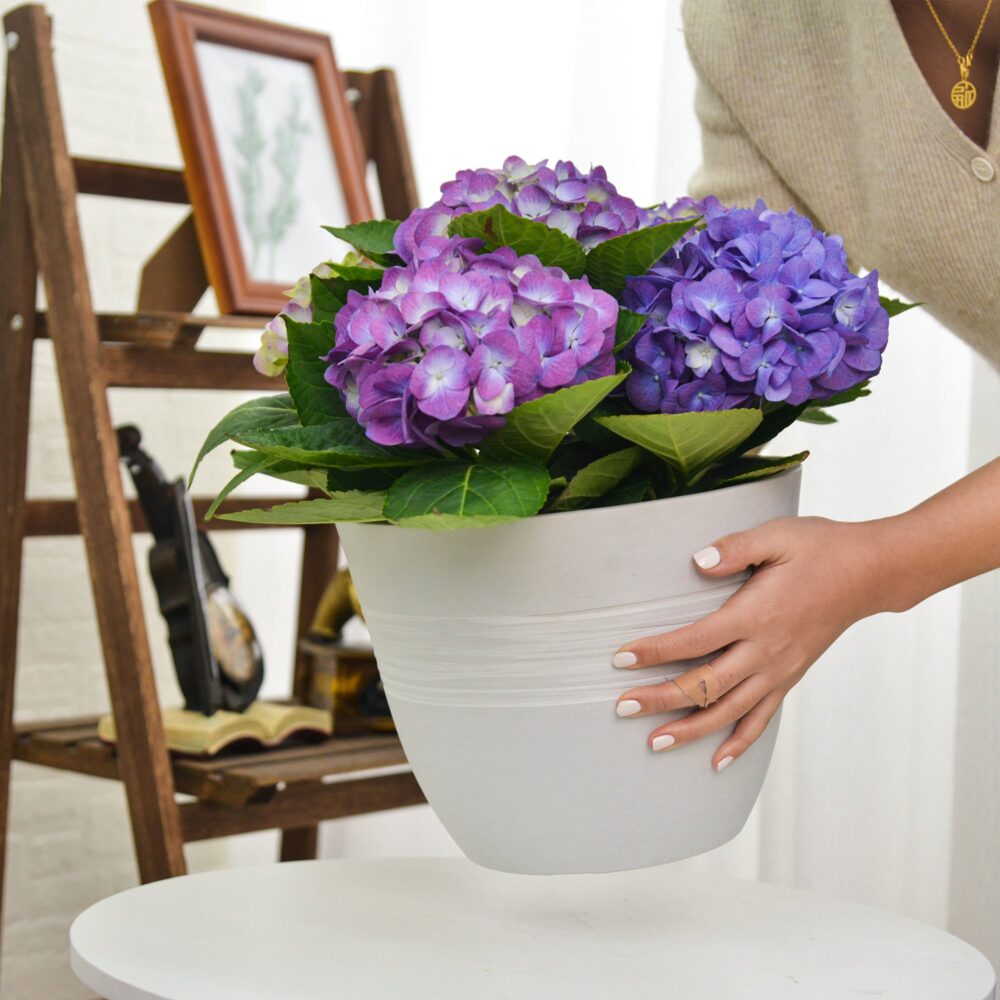Jasmine in Pots: The Complete Guide to Growing Arabian Jasmine Outdoors in Containers (Fragrant & Easy!)
Want to fill your patio, balcony, or garden with intoxicating fragrance and delicate beauty? Growing Jasmine (Jasminum sambac) in containers is a wonderfully easy and rewarding way to bring these beloved fragrant flowers into your outdoor spaces. Celebrated for their intensely sweet perfume, their delicate white flowers, their ease of growth, and their adaptability to container gardening, Jasmine (specifically Arabian Jasmine, Jasminum sambac, also known as Sambac Jasmine or Pikake) is perfect for creating a fragrant oasis in your outdoor living areas. This comprehensive guide will provide you with everything you need to know to grow Jasminum sambac successfully in outdoor pots, from selecting the best plants and containers to mastering essential care techniques for a fragrant and beautiful display.

Jasmine
What is Jasmine (Arabian Jasmine)?
Jasmine, when referring to fragrant garden plants, often refers to Arabian Jasmine, scientifically known as Jasminum sambac. Jasminum sambac is a popular evergreen shrub or vine belonging to the Oleaceae family (Olive family). Native to tropical Asia, likely originating in India, it is widely cultivated as an ornamental plant in warm climates worldwide, prized for its exquisite fragrance, beautiful white flowers, relative ease of care, and use in teas and perfumes. Arabian Jasmine plants are characterized by their vining or scrambling growth habit, dark green, glossy leaves, and highly fragrant, star-shaped white flowers that often open in the evening and are most intensely scented at night. Flowers can be single, semi-double, or double, depending on the cultivar. They exhibit a bushy, sprawling growth habitthat can be trained as a shrub or vine, typically reaching heights of 3-10 feet depending on pruning and support. They are known for their intense fragrance, beautiful and prolific blooms, ease of propagation, and adaptability to container culture, making them a popular choice for homes, patios, balconies, gardens, and courtyards, especially for creating fragrant gardens and outdoor living spaces.
Is Jasmine (Arabian Jasmine) Good for Outdoor Pots?
Yes, Arabian Jasmine is exceptionally well-suited for outdoor pots and container gardening, and is a popular choice for adding fragrance and beauty to patios, balconies, and other outdoor areas. Their adaptability to pruning, manageable size in containers, prolific flowering, and fragrant blooms make them ideal for container cultivation. Growing Jasmine in pots offers several advantages:
- Intense Fragrance: Potted Jasmine can be placed strategically to maximize fragrance enjoyment near seating areas, windows, or doorways, filling your outdoor spaces with their sweet perfume.
- Portability: Potted Jasmine can be easily moved to optimal locations for sunlight, display, or shelter from extreme weather (though they are quite resilient in warm climates). You can rearrange them to create fragrant focal points or seasonal displays.
- Controlled Environment: Container gardening allows you to provide the well-draining, slightly acidic soil mix that Jasmine prefers and control watering and fertilization more precisely, which is important for their specific needs.
- Manageable Size: Container growing naturally restricts the vigorous growth of Jasmine, keeping them to a more manageable and decorative size, ideal for patios and balconies. You can prune them to maintain desired shape and size.
- Pest and Disease Management: Container growing can help reduce some soilborne pest and disease issues that can affect Jasmine planted directly in the ground.
- Ideal for Patios and Balconies: Jasmine in pots is perfect for adding a touch of tropical elegance and intoxicating fragrance to patios, balconies, and other outdoor living spaces, creating a sensory-rich and inviting atmosphere.
- Cold Climate Flexibility: In regions with colder winters, potted Jasmine can be easily moved indoors to a bright, cool location to protect them from frost and freezing temperatures, and then brought back outdoors in warmer months to enjoy their blooms. (Though this is not strictly necessary in Singapore).
Ideal Growing Conditions for Jasmine (Arabian Jasmine) in Pots:
Light: Jasmine thrives in full sun to partial shade. When grown outdoors, they appreciate a location that receives at least 6 hours of direct sunlight per day for best flowering and fragrance production. They can tolerate partial shade, especially during the hottest part of the afternoon in very intense summer climates, but full sun is generally best for optimal bloom quantity and scent intensity. Choose a sunny location for your Jasmine containers, such as a south-facing patio, balcony, or garden. Inadequate sunlight will result in fewer flowers and less intense fragrance.
Soil: Jasmine needs well-draining soil that is rich in organic matter and slightly acidic. Use a high-quality potting mix specifically formulated for flowering plants, or a general-purpose potting mix amended for good drainage and acidity. Amend potting mix with peat moss, composted pine bark, or coco coir to increase acidity and improve drainage and aeration. Good drainage is crucial to prevent root rot, especially in containers. Avoid heavy, waterlogged soil. A slightly acidic to neutral pH (around 6.0-6.5) is ideal.
Watering: Jasmine prefers consistently moist soil during its active growing and blooming season, but dislikes soggy conditions. Water thoroughly when the top inch of soil feels slightly dry. Water deeply until water drains out of the drainage holes. Then, allow the topsoil to slightly dry before watering again. Avoid overwatering and consistently soggy soil, which can lead to root rot. Also, avoid letting the soil dry out completely, especially when plants are actively growing and blooming. Jasmine prefers a “moist but not waterlogged” soil environment. Watering frequency will depend on weather conditions, light levels, and pot size. Water more frequently during warmer, drier periods and less frequently during cooler, cloudier periods. In Singapore’s humid climate, monitor soil moisture regularly, especially during rainy periods, to ensure the pot is not sitting in waterlogged soil.
Temperature: Jasmine thrives in warm temperatures, ideally between 65-85°F (18-29°C) during the growing season. They are tropical and subtropical plants and are not frost-hardy. In Singapore’s consistently warm climate, temperature is generally ideal for Jasmine year-round. They can tolerate high heat well, but are damaged by frost and freezing temperatures. Consistent warm temperatures are essential for their growth and flowering.
Humidity: Jasmine prefers moderate to high humidity, reflecting their tropical origins. Singapore’s humidity is generally well-suited to Jasmine. They appreciate humidity and good air circulation.
Fertilizer: Jasmine is a moderate to heavy feeder, especially when grown in containers and expected to bloom profusely. Regular fertilization is key to promoting abundant flowering and strong fragrance. Fertilize every 2-4 weeks during the active growing and blooming season (spring through fall). Use a balanced liquid fertilizer (e.g., 20-20-20 or 10-10-10) diluted to half strength, or a fertilizer specifically formulated for flowering plants. Follow product label instructions for application rates. A fertilizer slightly higher in phosphorus (the middle number) can encourage better flowering. You can also supplement with Epsom salts (magnesium sulfate) diluted in water every few months to encourage lush growth and flowering. Reduce or stop fertilizing during the dormant season (winter). Consistent feeding is important to fuel their vigorous growth and continuous, fragrant bloom production.
Choosing the Right Pots for Jasmine (Arabian Jasmine):
Suitable Pot Types: Jasmine can be grown in various pot types, but drainage and providing support for vining growth are key considerations. Suitable pot types include:
- Terracotta Pots: Terracotta is a good choice as it provides excellent drainage and aeration, helping to prevent overwatering, and offers a classic, warm look. Larger, heavier terracotta pots are recommended for stability, especially for larger Jasmine plants that may become top-heavy or need support structures.
- Ceramic Pots: Glazed or unglazed ceramic pots can be used, offering a wide range of decorative styles. Ensure they have drainage holes and are sturdy enough for the plant size and any support structures. Choose based on your desired aesthetic and stability needs.
- Resin Pots: Lightweight, durable, available in styles mimicking terracotta or ceramic, and offer a balance of drainage and moisture retention. Resin pots are a good alternative to heavy terracotta or ceramic, and often more durable than terracotta or plastic. Choose sturdy resin pots that can support trellises or stakes if needed.
- Plastic Pots (Sturdy): Sturdy, good quality plastic pots can be used, especially for larger plants, as they are lightweight and durable. Ensure excellent drainage and be careful not to overwater in plastic pots as they retain moisture. Choose pots that are strong enough to support trellises or stakes if you plan to train your Jasmine as a vine.
Drainage: Excellent drainage is absolutely essential for Jasmine to prevent root rot. Ensure your chosen pot has multiple drainage holes at the bottom. Avoid pots without drainage holes. Always use a drainage layer at the base of the pot (e.g., a layer of gravel or pot shards) beneath the potting mix to further enhance drainage. Elevating pots slightly on pot feet or bricks can also improve drainage and air circulation.
Pot Size: Choose pot sizes appropriate for the size and variety of your Jasmine and your desired display. Jasmine will need repotting as it grows.
- Starting Size (Young Plants): For young Jasmine plants (e.g., from 1-gallon nursery pots), start with a pot that is 10-12 inches in diameter.
- Mature Size (Established Plants): For established Jasmine plants, choose pots that are 14-20 inches in diameter or larger, depending on the desired size of the plant and whether you plan to train it as a shrub or vine. Larger pots will allow for more growth and provide space for support structures like trellises or stakes. Repot gradually into slightly larger pots as needed every 1-2 years, especially for younger, faster-growing plants.
- Depth: Pots should be at least 12-18 inches deep to accommodate the root system and provide space for a trellis or support if desired.
Stability: Jasmine can become quite bushy or vining, and may need support. Stability is a consideration, especially for outdoor containers exposed to wind or if you are training Jasmine as a vine on a trellis. Choose heavy pots made of terracotta, ceramic, or sturdy resin, especially for larger plants or those with trellises. Wider pots are generally more stable than tall, narrow pots.
Color and Style: Choose pot colors and styles that complement the delicate white flowers and green foliage of your Jasmine and your outdoor décor, and enhance their fragrant, elegant appearance. White, cream, terracotta, or pastel-colored pots can create a classic and romantic look, highlighting the white flowers and enhancing the fragrance. Darker pots in shades of green, gray, or charcoal can provide a sophisticated contrast and make the white flowers stand out. Consider the overall style of your patio or balcony and choose pots that harmonize with the surroundings and enhance the desired fragrant, elegant garden ambiance.
Essential Care Tips for Thriving Jasmine (Arabian Jasmine) in Outdoor Pots:
- Watering: “Keep Soil Moist, Avoid Soggy Soil”. Water thoroughly when the top inch of soil is slightly dry during the growing season. Water deeply and ensure good drainage. Allow topsoil to slightly dry between waterings. Avoid overwatering.
- Sunlight: Provide Full Sun to Partial Shade (at least 6 Hours of Sun for Best Bloom and Fragrance). Place Jasmine pots in a location with full sun to partial shade outdoors. Full sun is best for abundant blooms and intense fragrance.
- Fertilizing: Fertilize Every 2-4 Weeks During Growing Season with Balanced Liquid Fertilizer. Fertilize regularly during the spring and summer growing season to promote healthy growth and abundant flowering. Use a balanced liquid fertilizer. Supplement with Epsom salts occasionally. Reduce or stop fertilizing during dormancy.
- Pruning (Encourage Bushiness and Bloom): Prune Jasmine regularly to maintain desired shape and size, control vigorous growth, and encourage more branching and flowering. Prune after each major bloom cycle to stimulate new growth and more flower buds. Harder pruning can be done annually in late winter or early spring to control size and rejuvenate plants.
- Training and Support (for Vining Types): Provide support for vining types to climb, such as trellises, stakes, or walls. Tie stems to supports as they grow. Prune to maintain desired shape and encourage branching.
- Winter Care (Protect from Frost if Necessary): In Singapore, no winter protection is needed. In regions with frost, move potted Jasmine indoors to a bright, cool location during winter, or provide frost protection outdoors. Reduce watering and fertilization during winter dormancy.
- Pest and Disease Control: Monitor for common pests like aphids, spider mites, and mealybugs. Treat with insecticidal soap or neem oil if needed. Good air circulation and proper watering practices help prevent most issues. Root rot can occur if soil is waterlogged.
Popular Jasmine Cultivars (and Flower Types):
Arabian Jasmine (Jasminum sambac) has several popular cultivars distinguished by flower form and size:
- Jasminum sambac ‘Grand Duke of Tuscany’ (Double): Large, highly fragrant, double flowers resembling small gardenias. Flowers are long-lasting. More shrub-like growth habit. Very popular cultivar.
- Jasminum sambac ‘Maid of Orleans’ (Single to Semi-Double): Single to semi-double flowers, very fragrant, classic Jasmine scent. More vining growth habit. Another very popular and reliable cultivar.
- Jasminum sambac ‘Belle of India’ (Double): Double flowers, very fragrant, slightly more compact and upright growth habit than ‘Maid of Orleans’.
- Jasminum sambac ‘Mysore Mulli’ (Semi-Double): Semi-double flowers, very fragrant, known for heavy blooming.
- Jasminum sambac ‘Arabian Nights’ (Double): Very double, ruffled flowers, strong fragrance.
- Jasminum sambac ‘Rose Pink Jasmine’ (Pink Buds, White Flowers): Features pink buds that open to white flowers. Fragrant.
In Summary:
Growing Jasmine (Jasminum sambac) in outdoor pots is a wonderfully rewarding way to create a fragrant and beautiful outdoor oasis on your patio, balcony, or garden. Their intoxicating perfume, delicate white flowers, and relatively easy care make them a perfect choice for container gardeners of all levels, especially those seeking to add fragrance and tropical elegance to their outdoor spaces. By providing full sun to partial shade, well-draining, slightly acidic potting mix in pots with excellent drainage and stability, keeping the soil consistently moist during the growing season, regular fertilizing, and consistent pruning to shape and encourage blooms, you can easily cultivate thriving and exquisitely fragrant Jasmine plants in pots and enjoy their delightful perfume and beautiful flowers in your outdoor living spaces for years to come.

Jasmine
For more detailed botanical information and to explore the diverse world of Jasminum sambac (Arabian Jasmine), you can visit the Wikipedia page on Jasminum sambac.
Important Note: The key to success with Jasmine is providing enough sunlight for best flowering and fragrance, ensuring excellent drainage to prevent root rot, and regular watering and feeding during the growing season. With proper care and a sunny location, your potted Jasmine will reward you with an abundance of exquisite, fragrant blooms and transform your outdoor space into a fragrant paradise!**
KC2-11V
By greenship|2024-08-16T05:39:50+00:00August 16, 2024|Categories: Hand-carving Series|
Modern Plant Pots with Drainage – Indoor & Outdoor Use (6″ Widths)
By greenship-seo|2025-04-10T06:29:43+00:00February 6, 2025|Categories: Hand-carving Series|Tags: Decorative Flower Pots|
KC3-09k
By greenship|2024-08-16T06:24:36+00:00August 16, 2024|Categories: Hand-carving Series|
13 inch Planter for Indoor Plants, Set of 2 Modern Decorative Plant Pots with Drainage Hole, Cute Bowl Shape Flower Pots
By greenship-seo|2025-04-10T07:41:46+00:00January 10, 2025|Categories: Hand-carving Series|Tags: Decorative Flower Pots, Self-Watering Pots|
Planter 6 in W / 8 in W / 12 in W Indoor or Outdoor Plants, Modern Decorative Plant Pots with Drainage Hole, Decorative Flower Pots
By greenship-seo|2025-02-06T13:43:53+00:00January 16, 2025|Categories: Hand-carving Series|Tags: Decorative Flower Pots|
Planter for Indoor Outdoor Plants, Set of 2 Modern Decorative Plant Pots with Drainage Hole, Decorative Flower Pots
By greenship-seo|2025-01-14T12:26:44+00:00January 14, 2025|Categories: Hand-carving Series|Tags: Decorative Flower Pots|






